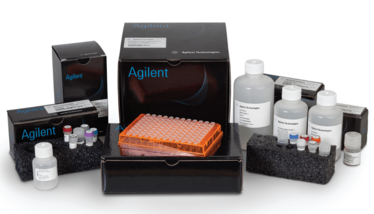Top Tips for mRNA Sequencing
mRNA has become a superstar thanks to the success of mRNA-based COVID-19 vaccines, but its importance was known long before the pandemic. Bellal Moghis from the Diagnostics and Genomics Group at Agilent Technologies tells us about the potential of mRNA – and the challenges of working with and analyzing mRNA.

What attention was on mRNA prior to COVID-19?
mRNA has been key to understanding molecular pathways that underlie disease susceptibility or drug response. For this reason, scientists have used techniques such as quantitative real time-polymerase chain reaction (qRT-PCR) to understand how genes are regulated within a molecular pathway, or microarrays to understand how multiple genes are modulated in response to cellular changes. Insights from these experiments have allowed scientists to develop therapeutics to target faulty gene pathways that lead to disease. Now that high-resolution technologies such as next-generation sequencing are more accessible, mRNA is being considered at the individual sample level, allowing us to realize the benefits of personalized medicine. Most recently, just prior to the COVID-19 pandemic, mRNA was used to increase the clinical utility of diagnostic genetic tests (1). By conducting mRNA sequencing alongside DNA sequencing, some variants of unknown clinical significance can now be elucidated, improving diagnostic yield and aiding treatment.
What are the challenges of analyzing mRNA?
mRNA sequencing has long been a core workflow in many labs; however, it has a unique set of challenges. mRNA degrades significantly faster than DNA, so it is often frozen at -80oC for long-term storage. Before mRNA can be used in a sequencing workflow, its quality must first be assessed using reliable, automated benchtop capillary electrophoresis systems. Because genes are differentially expressed, experimental design is another important consideration to ensure that all genes of interest are detectable and quantified properly, with scientists required to choose between sequencing the global gene expression profile of a sample or enriching certain genes to study them in isolation. Once the samples have been sequenced, the scientist is then tasked with analysis, which can be cumbersome for new users. Luckily, there are several analysis software solutions on the market today that guide users and aid in interpretation.
How are technologies for mRNA sequencing advancing?
Sequencing technologies are becoming more accessible, allowing scientists to leverage large mRNA data sets to aid in clinical and diagnostic research. Though there is much more to be done in understanding how mRNA can provide clearer insights to disease, the information we currently have is already being used in labs across the world to gain more clinical utility from sequencing data. It is my belief that cancer diagnostics and treatment management has advanced significantly from these studies. Today, targeted treatments can be prescribed based on the mRNA profiles of cancer patients – namely, the presence of fusion genes that have been shown to directly cause cancer, such as BCR-ABL fusions found in some types of leukemias. As clinical research scientists continue to make advancements in understanding how mRNA can be used as an effective biomarker for cancers, pharmaceutical companies and molecular diagnostic providers can continue to develop effective diagnostic tools.
What are your top tips and best practices for sequencing mRNA?
Although there are many commercially available kits to guide new users through the process of sequencing mRNA, here are a few important considerations:
- As mentioned above, RNA is less stable than DNA, so sample preparation must be handled with care. Decontaminating workspaces during RNA isolation is a critical step to avoid introducing RNase, an ubiquitous enzyme that rapidly degrades RNA, into your sample. Although storage of your RNA will require a -80oC freezer, thawed RNA in use should remain on ice throughout library preparation.
- Assessing the quality of your RNA sample is key to ensure that your time and resources are not wasted preparing a sample that is destined for failure. There are many solutions that can help you understand both the quality and the quantity of your starting material, so take advantage!
- It is important to consider different approaches (either mRNA capture or ribodepletion) based on the quality of your samples. Since mRNA capture typically requires a 3′ poly-A tail, mRNAs that are fragmented and missing the 3′ poly-A tail may be missed. Ribodepletion, in which the highly abundant ribosomal RNAs are removed from the sample and the remaining mRNA is sequenced, is often considered in these cases.
- Maintaining consistency between sequencing runs is critical for comparing samples run in different batches. Like qPCR experiments, the preparation, sequencing, and analysis of samples should be normalized.
How excited are you at the future potential of mRNA?
The impact of mRNA as a diagnostic tool or, in the case of vaccines, a medicine, will continue to improve outcomes in cancer, genetic disorders, and infectious disease. By quickly producing RNA vaccines in vitro to specific antigen targets, precious time and lives can be saved. The potential of RNA vaccines is immense and in its infancy, but the highly positive results from the COVID-19 vaccines have shown the world what is possible. And, in the future, even more cutting-edge solutions will be available.
Image Credit: Submitted by company
- Ambry Genetics, “3 Ways RNA Analysis will Change the Future of Genetic Testing,” (2019). Available at https://bit.ly/3tAj1yE



















